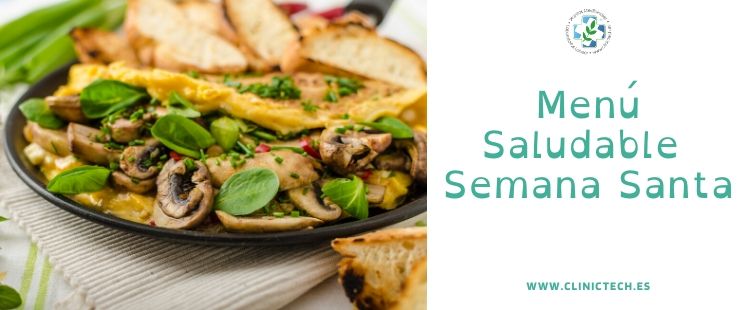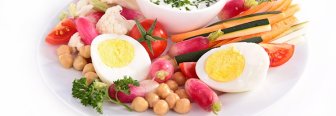
Menú de Semana Santa saludable
08 Apr 2020Cuando la Semana Santa se acerca, aprovechamos para desconectar de nuestra rutina y disfrutar más los días junto a nuestra familia. Inevitablemente, esto va acompañado de los platos típicos de la época. A menudo terminamos excediéndonos, aun siendo conscientes de que no es lo mejor para mantenernos saludables. Por ello, queremos proponerte un menú de Semana Santa saludable y equilibrado, pero también sabroso y con postre dulce.
Cómo preparar el menú especial de Semana Santa
Te traemos la solución con estos cuatro platos que conforman el menú perfecto para estas fechas, aquí tienes sus recetas paso a paso:
El arroz con bacalao es uno de los platos tradicionales que más gustan. Y no es para menos, ya que además de presentar un sabor intenso es muy sencillo de hacer y requiere de pocos ingredientes. Veamos la receta de este exquisito arroz.
Ingredientes:
- 250 gramos de arroz,
- 2 ajos,
- 1 pimiento rojo,
- 500 gramos de bacalao desalado,
- 1 litro de fumet de pescado,
- azafrán.
Cómo hacer un arroz con bacalao
1. Cortamos los ajos en láminas y los doramos en una paella.
2. A continuación, añadimos el pimiento rojo previamente cortado en dados. Lo rehogamos hasta que se ablande, aproximadamente 12 minutos.
3. Incorporamos el bacalao desalado cortado en daditos. Si decidimos hacerlo con bacalao sin desalar, deberemos dejarlo a remojo durante 48 horas.
4. Añadimos el arroz y rehogamos durante varios minutos.
5. Cubrimos con el fumet de pescado. En este punto es conveniente recordar que no debemos añadir sal. Tanto el bacalao como el caldo de pescado ya nos proporcionan el punto de sal necesario.
6. Finalmente, incorporamos el azafrán y lo dejamos cocinar a fuego medio unos 18 minutos. ¡Y listo!
✔️Tortilla de vegetales
La tortilla de verduras es un plato muy versátil durante todo el año. Pero, especialmente, en Semana Santa nos gusta degustar una buena tortilla de vegetales. Tradicional, rápida y con todos los nutrientes necesarios para la salud.
Ingredientes
- Huevos,
- cebolla,
- ajos,
- pimiento,
- calabacín,
- berenjenas,
- espárragos,
- champiñones.
La cantidad de ingredientes variará en función de los comensales.
Cómo preparar una tortilla de verduras
1. Lavamos bien las verduras y las troceamos en láminas o trozos pequeños.
2. A continuación, batimos los huevos con una pizca de sal. Cuantos más huevos añadamos menos apelmazada quedará la verdura.
3. Ponemos una sartén con aceite de oliva a fuego lento hasta que el aceite alcance una temperatura alta. Añadimos las verduras y rehogamos hasta que queden blandas, pero no demasiado hechas.
4. Te sugerimos este paso extra: añadir un poquito de vino blanco para potenciar su sabor y una mezcla de especias al gusto. Y tú, ¿eres tan amante de las especias como nosotros?
5. Sacamos la verdura, la escurrimos bien y la mezclamos con el huevo.
6. Añadimos la mezcla a la sartén a fuego lento hasta que cuaje. La podemos degustar fría o caliente. ¡Tú decides!
✔️Buñuelos de Cuaresma
Los buñuelos de Cuaresma son una receta clásica donde las haya. Su principal característica es que la masa se aromatiza con vino blanco, ralladura de cítrico y anís en grano.
Ingredientes
- 150 gramos de leche,
- 30 gramos de mantequilla,
- una cucharadita de anís en grano,
- ralladura de un limón,
- 15 gramos de moscatel,
- 80 gramos de harina,
- 1 huevo.
Preparación de los buñuelos:
1. En un cazo mezclamos la leche con la mantequilla, azúcar, anís, ralladura de limón, el vino y una pizca de sal. Llevamos a ebullición y retiramos. Añadimos la harina de un golpe y removemos enérgicamente.
2. Enfriamos y añadimos el huevo. Pasamos la mezcla a la manga pastelera y freímos bolitas pequeñas en tandas de 10.
3. Una vez fritos, los escurrimos en papel sulfurizado y rebozamos con azúcar y canela antes de servir. ¡Deliciosos!
En definitiva, la Semana Santa no es sinónimo de cocina poco saludable.
¿Os animáis a probar este menú de Semana Santa y contarnos qué tal?




 Músculo
Músculo
 Óseo
Óseo
 Grasa
Grasa
 Caloría
Caloría
 Índice Masa Corporal
Índice Masa Corporal
 Agua
Agua
 Cálculo
Cálculo

